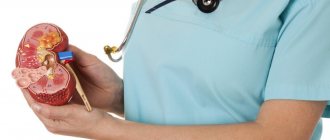Features of the structure of the urethra in women
The urethra in women is shorter and thinner than in men. The inside walls are covered with mucous membrane, followed by a layer of muscle tissue and connective fibers. The length of the urethra in women is from three to five centimeters, and the diameter is no more than one and a half centimeters.
The function of the organ in women is to excrete urine, and in men it also excretes seminal fluid.
Microflora is becoming a common cause of discomfort in the urethra in women. The number of pathological microorganisms depends on the age of the patient and the state of her immunity. In a healthy adult woman, the vast majority of microorganisms are lactobacilli. Saprophytic staphylococci and epidermal staphylococci on the mucous membrane are also acceptable. The presence of up to 10% of bifidobacteria is also considered normal for women from thirty to sixty years old.
Neoplasms of the urethra
The urinary organs are susceptible to the formation of polyps, cysts, condylomas, and cancerous tumors.
A small protrusion on the wall of the urethra, a polyp, interferes with urination, bloody discharge from the urethra appears, but not always. Often the disease is asymptomatic. Sometimes a polyp, growing from the edge, prevents the urethra from closing, which leads to enuresis.
Genital warts sometimes form on the walls of the urethra - the only tumor of viral origin that is transmitted to sexual partners.
Sometimes these tumors disappear on their own, but the human papillomavirus remains in the body, and condylomas can reappear. In a neglected state, they rarely degenerate into malignant ones.
In patients with a paraurethral cyst, the vaginal wall bulges above the canal as the glands located behind the urethral opening fill with fluid. At the initial stage there is no pain, then the cyst can fester and break into the urethra. Then urine excretion becomes difficult and the temperature rises. Paraurethral cyst is treated surgically.
Cancer of the urethra is rare. The tumor affects any part of the urinary duct, but most often the external urethral outlet, located near the vulva.
Methods for examining the condition of the urethral mucosa
To accurately diagnose the causes of discomfort in the urethra, women most often take a smear. Such a study is carried out in the direction of a nephrologist, gynecologist or urologist. The purpose of taking a smear is to determine the presence of infection, type of pathogens, pathogenic microflora, erosions or ulcers.
Indications for taking a smear from the urethra are the following conditions:
- Pain and burning when urinating.
- Unpleasant sensations in the urethral area.
- Suspicion of an inflammatory process.
- Suspicion of the presence of sexually transmitted diseases.
A smear can be taken directly in the office of a gynecologist or urologist if it is a preventive examination. This procedure is quite painful if the urethral mucosa is irritated.
Before taking a smear to determine the cause of discomfort in the urethra in women, you need to follow some rules:
- Seven days before the test, do not take antibiotics.
- Seven to ten days before taking a smear, do not drink alcoholic beverages.
- Do not have sexual intercourse for twelve hours.
- An hour or two before the test, do not urinate.
To accurately diagnose the cause of the problem, the following tests are performed:
- Urine according to Nechiporenko.
- Bacteriological culture.
- Blood chemistry.
- Blood test for glucose levels.
- Ultrasound of the pelvis.
What folk recipes can be used for urethritis?
Urethritis must be treated with medications. It is impossible to replace them with folk remedies. However, the anti-inflammatory properties of many plants may well help medications. For this purpose, herbs and fruits are selected that also have diuretic, antimicrobial and antispasmodic properties.
Recommended to be taken orally with food and drink:
- juices from lingonberries, cranberries, carrots (we are talking only about fresh juices without preservatives and sugar);
- celery greens, parsley, beets;
- A decoction is prepared from the berries and leaves of black currant (half a liter of boiling water for 3 tablespoons of the dry mixture), infuse it for 30 minutes, drink it 2-3 times a day;
- prepare a mixture in milk from the leaves and stems of parsley (simmer in the oven for 1 hour);
- a decoction of linden blossom is known for its ability to relieve burning and pain when urinating;
- Cornflower flowers are dried and used as tea.
The composition of plant components can be changed, different herbs can be combined into collections. They need to be stored separately. Examples of fees:
- mint leaves,
- calamus roots,
- nettle leaves and stems.
- elderberry flowers,
- juniper berries,
- horsetail.
To infuse, take an equal amount, brew overnight in a thermos, and drink over the next day.
- St. John's wort,
- sage,
- horsetail,
- wheatgrass roots,
- caraway fruits.
- knotweed,
- shepherd's purse,
- tansy flowers.
- heather grass,
- fennel,
- motherwort,
- immortelle flowers,
- black poplar buds.
In the acute form of urethritis and during exacerbation of the disease, it is recommended to use herbal decoctions for no longer than a month. Then take a break for 1.5–2 months and repeat the course. In chronic cases, treatment with folk remedies lasts for years.
Women need to come for examination to a gynecologist at least twice a year, even if nothing bothers them
Causes of discomfort in the urethra in women
It is difficult to determine the exact cause on your own. Most often, this purpose requires an examination by a nephrologist, gynecologist or urologist and study of test results. The most common causes of discomfort in the urethra in women:
- Allergic reactions to certain types of medications, food products, and underwear made from synthetic materials.
- Various injuries.
- Cystitis.
- Urogenital infections.
- Urethritis and urogenital chlamydia.
- Gonorrhea and trichomoniasis.
- Inflammation of the cervix.
- Increased emotional and physical stress.
- Infectious diseases of the urinary system.
After a competent diagnosis, we can talk about prescribing medication.
General recommendations
The effectiveness of therapy will not be effective without following general recommendations. First of all, you should avoid eating spicy, pickled, salty foods, as they contribute to increased concentration of urine. Women at this time need to follow a dairy, plant-based diet. While taking medications, you should avoid physical activity, completely avoid sexual intercourse, stay cool, and do not drink alcohol.
For your own relief, you can perform warming treatments that apply dry heat to the lower abdomen. Since the heat is dry, it is good to use a heating pad, a bag of salt, and the heat temperature should not exceed 40 degrees. No-spa will help not only eliminate pain, but also eliminate vascular spasm, which worsens diuresis. If there are blood stains in the urine, heating and taking medications are prohibited. In this case, you can use a decoction of cherry twigs to relieve discomfort.
The appearance of itching in the urethra is a symptom of many diseases that require consultation with a doctor. After making a diagnosis, he will prescribe effective treatment to determine the cause of discomfort.
Urogenital infections
The most common infections that cause discomfort in the urethra in women:
- Chlamydia is an infectious disease that is sexually transmitted. It is characterized by a burning sensation when urinating and discomfort in the urethra throughout the day.
- Symptoms of candidiasis - in addition to burning and pain in the urethra during urination, the presence of cheesy discharge with an unpleasant odor from the vagina is also characteristic.
- Genital herpes leads not only to a burning sensation in the urethra in women, but also to the appearance of rough or smooth lumps that are painful when pressed.
- Bacterial vaginosis is a type of urogenital infection that can develop only in one case - if the microflora of the vaginal mucosa does not have a sufficient number of lactobacilli.
Symptoms of urogenital infections in women:
- Burning, pain when urinating.
- Pain in the pelvic area.
- Severe swelling of the labia.
- Inflammation of the cervical canal, fallopian tubes.
- Inflammation of the walls of the vagina and the large gland of its vestibule.
Urolithiasis, prolapse
There are diseases of the urethra associated with the formation of stones and urethral prolapse:
Urolithiasis affects people of different age groups. Stones form in the bladder and urinary duct. When stones come out along with urine, injuring the mucous membrane, acute pain occurs. Due to blockage of the duct by stones, the bladder does not empty completely. The choice of treatment - therapy or surgery - is determined by the number and size of stones.
Prolapse is the loss of all layers of the urethral wall through the opening, complete from the outside: (along the entire length) or incomplete (lower part). The reason for the prolapse of the urethra is the downward displacement of the bladder due to weakening of the ligamentous-muscular apparatus that holds it.
Externally, it is a mucous formation at the opening of the urethra. The disease is alarming only when sexual life is disrupted, pain is felt when walking, and urine output is complicated. Prolapse requires surgery.
Urogenital chlamydia
Chlamydia of the urogenital type manifests itself as an inflammatory disease of the genitourinary organs, prostate gland, and bladder. It can only be contracted through sexual intercourse. The infection can occur in both men and women. Both a man and a woman can become a carrier.
Symptoms of urogenital chlamydia in women are as follows:
- Purulent vaginal discharge.
- Curdled, thick mucus with an unpleasant odor from the vagina.
- Slight increase in temperature.
- Weakness and asthenia.
- In parallel, urethritis, cystitis, and bacterial vaginosis develop.
Diagnosis of urogenital chlamydia is quite complex and consists of several research methods:
- Cytological (examination of biological material under a microscope to determine the type of pathogen. This method is not always effective.
- Immunofluorescence, in which smears taken from the urethra are stained with anti-chlamydial antibodies - a fluorescent component is introduced and the glow of microorganisms is detected under a special microscope.
- The serological method identifies pathological microorganisms by the reaction of immunoglobulins.
- Molecular biological - conducting a polymerase chain reaction to search for deoxyribonucleic acid in a smear from the urethra and cervical canal.
What factors contribute to the disease?
In addition to the impact of a specific pathogen, the following factors influence the occurrence of inflammation in the urethra:
- hypothermia of the body;
- injury to the genital organs, disruption of innervation during surgery on the uterus and vagina;
- decreased immunity after suffering stress or serious illness;
- undermining the body’s protective function through poor nutrition and restrictive diets;
- consequences of alcoholism;
- hypo- and vitamin deficiencies;
- the presence of chronic inflammatory diseases (tonsillitis, tuberculosis, sinusitis, caries, cholecystitis, adnexitis);
- diseases of the urinary system;
- pregnancy and menopause;
- ignoring the rules of personal hygiene.
Urethritis in women: symptoms and signs
The most common reasons for the development of this disease are:
- The presence of latent and overt sexually transmitted infections.
- Damage to the mucous epithelium of the genitals.
- Violation of sterility during medical procedures (for example, inserting a catheter into the urethra).
- Local or general hypothermia.
- Chronic inflammatory diseases of the kidneys and bladder.
The causes of chronic urethritis are varied. Based on them, urology divides the disease into two types: infectious and non-infectious urethritis. Treatment for each of these types has important differences.
The main symptoms of urethritis in women (if the disease is infectious) are most often accompanied by a slight increase in temperature. The patient also develops weakness, asthenia, severe and sharp pain in the urethra when urinating. In this case, it is necessary to undergo examination by a urologist and gynecologist to accurately determine the type of infectious agent. After this, a course of effective antibiotics will be prescribed.
With urethritis of a nonspecific nature, the disease is milder and does not cause pronounced discomfort. This type of urethritis is characterized by the release of mucus with an unpleasant odor.
Classification
Based on the activity of manifestation, there are 2 main forms: acute and chronic.
Acute urethritis manifests itself sharply, has pronounced symptoms and a relatively short period of development - no more than 2 months. The prognosis is favorable.
The chronic variant occurs unnoticed by the patient or has vague, mild symptoms. The period of development can last for years, alternating stages of remission with periodic exacerbations; with a prolonged process, it often provokes complications.
Based on their occurrence, the following types of urethritis are distinguished:
- infectious – the causative agent of the pathological process is bacteria, fungi, and less commonly viruses;
- non-infectious (mechanical) – develops against the background of injuries to the urethra and pathological narrowing of its duct with stagnation of urine;
- allergic - in the form of a sensitization reaction to condoms, hygiene products, tissue composition, medications, less often - to the diet (spices, biologically active substances);
- chemical – irritation of the urethral mucosa by chemicals (medicines, household chemicals, third-party chemicals) – not to be confused with the allergic form!
Infectious urethritis is the most common option. It can occur independently or accompanied by one of the above-mentioned forms, which aggravates the overall course of the disease. It has its own classification system.
According to the type of pathogen it can be:
- specific – infection with pathogens of urogenital infections: gonococci, trichomonas, chlamydia, ureaplasma, mycoplasma, candida;
- nonspecific - the main role is played by microbes nonspecific to the genitourinary system: Escherichia coli, streptococci, staphylococci.
According to the source of pathogenic microflora:
- primary - the microorganism enters directly into the urinary tract as a result of sexual contact, medical manipulations in the perineal area, swimming in a polluted body of water, etc.;
- secondary - the infection spreads to the urethra from other parts of the genitourinary system with cystitis, pyelonephritis, prostatitis, vaginitis, etc.
Specific forms are typical mainly for young people under 30-40 years of age. Nonspecific - develop at any age.
On a note! The viral form is much less common than the bacterial or fungal form. The main causes are human papillomavirus (HPV), herpes virus, cytomegalovirus; Often the disease manifests itself against the background of AIDS infection.
Gonorrhea and trichomoniasis
Among sexually transmitted diseases, the most common causes of discomfort in the urethra in women are gonorrhea and trichomoniasis. The manifestations of these ailments are very similar. However, treatment will vary dramatically.
Trichomoniasis is caused by urogenital Trichomonas. This is a single-celled microbe that multiplies very quickly in the human body, gaining a foothold in the organs of the urinary system. After a few days, urogenital Trichomonas multiplies to such an amount that can provoke an inflammatory process.
In relatively rare cases, trichomoniasis can be transmitted through household means, for example, through a toilet seat or a shared towel. In conditions of high humidity and heat, Trichomonas can continue its life activity outside the human body for some time.
A feeling of discomfort in the urethra is also characteristic of gonorrhea. Gonococcus is the causative agent of this disease. After entering the body, it does not manifest itself in any way for two weeks, and then becomes the cause of the inflammatory process.
You can become infected with gonorrhea in the following ways:
- Sexual intercourse.
- By everyday means (probability is low).
- Transmission from mother to baby (through the birth canal).
Diagnostics
In order to receive adequate treatment, prescribe the right medications for the treatment of urethritis and prevent this disease from developing into a more severe form, you will need a full diagnosis. The examination must be carried out in full: the patient will have to undergo both the laboratory part and the instrumental part. But this event always begins with a survey and inspection. The combination of all the listed points will allow you to recreate an accurate clinical picture, understand the existing problem, and begin to eliminate the pathology.
1. Questioning and inspection. First, it is carried out by a gynecologist, then by a urologist. In previous years, this diagnostic procedure was not relevant. According to the current standards of the healthcare system, a woman’s complaints of pain inside the pelvic organs or in the lower back require a preliminary assessment by a gynecologist. This tactic is explained by the similarity of the manifestations of existing pathologies. For example, cystitis can manifest itself as pain when urinating, like gonorrhea, and pain in the genitals is often caused by vulvitis, but not urethritis. Having received the conclusion of an examination by a female doctor (who, in the presence of urethritis, will rule out pathology in her activity profile), the woman is sent to a urologist.
2. Laboratory diagnostics. Tests for urethritis involve examining a urine sample (general analysis), blood from a vein and a finger. A clinical blood test (preferably a detailed formula) in the case of urethritis will show leukocytosis - an increased content of white blood cells. Similar results will be found in a urine sample - leukocytes sometimes occupy the entire field of view of the laboratory technician - that is, the inflammation is in an acute stage, which requires immediate therapeutic action. A biochemical blood test will determine the content of urea, sugar, and prothrombin index (these indicators are especially important if urethritis occurs as a result of surgery).
The doctor prescribes other types of laboratory tests in accordance with assumptions about the development of the disease and the spectrum of its damage at the time the patient goes to the hospital. For example, if a specialist suspects that urethritis has spread to the bladder tissue or involved the kidneys in the inflammatory process (pyelonephritis), then one of the appointments will be a blood test for createnine, determining the functional capacity of the kidneys using the Zimnitsky test.
It is important to note!
Antibiotics for urethritis are not prescribed until data from a bacteriological urine test is obtained. This study helps determine in a laboratory setting which pathogenic microorganism caused the development of inflammation. Taking into account the specific pathogen, a medication is prescribed. Otherwise, the prescription of an antimicrobial agent is considered incorrect (if antibiotic therapy was started without prior urine culture).
If the previously mentioned diagnostic measures are clear to everyone, then not every woman has had to undergo a urine culture for bacteriological examination. The procedure goes as follows:
1. All actions are carried out by a nurse - the presence or participation of a doctor is not required. All consumables and necessary instruments have been prepared in advance: tweezers (or a clamp), a catheter for urination, a sterile jar, a tray, napkins (they are made from a piece of gauze), sterile cotton balls, glycerin, an antiseptic solution (usually Chlorhexidine). All stages are carried out wearing disposable gloves.
2. In the dressing room of the urology department, the patient is placed on a couch (the surface of the equipment is previously covered with a diaper). The woman lies on her back, legs bent at the knees and spread apart.
3. Despite fulfilling the request to come for the procedure after performing intimate hygiene, the nurse additionally treats not only the external, but also the internal genital organs with an antiseptic solution. This medicine is used to treat the genitals and urethra.
4. After moistening the end of the catheter with glycerin, insert it into the woman’s urethra.
5. Urine, which will be released immediately after the catheter enters the urethra, is collected in a sterile container and sent for testing to the laboratory.
6. The canal and genitals are re-treated, then the woman can get dressed.
The research answer is received in at least three days (depending on the workload of the laboratory technicians).
Ultrasound is also prescribed - the most informative type of diagnosis, which will determine not only the fact of inflammation of the canal, but also the spectrum of damage. Determines whether nearby organs and structures are involved in the pathological process.
Inflammation of the cervix
This is the most common cause among genital diseases, which provokes a burning sensation in the urethra in women.
Causes of cervical inflammation:
- Hypothermia.
- Sitting for a long time on a cold surface.
- Low general and local immunity.
- Inflammatory process in neighboring organs.
If you start therapy at the first stage of the disease, the inflammation goes away quite easily. Antibiotic or anti-inflammatory drugs, as well as immunomodulators, may be prescribed for treatment.
External hole
In the male half of humanity, the main part of the urethra passes inside the penis, and the outlet is located at the top of its head. If it is not there, the disorder is called hypospadias. If there is partial or complete clefting of the anterior wall of the urethra, the disorder is called epispadias.
The external urethral canal in the fair sex is located between the clitoris (slightly below it by about 3 mm) and the entrance to the vagina.
The location of the external opening may vary. If the lower wall is underdeveloped, it will be located on the anterior wall of the vagina, distant from the entrance.
This process is called hypospadias. The outer hole has a diameter of approximately 0.5 cm, its shape can be round or star-shaped.
Increased emotional and physical stress
Women should not underestimate the impact of chronic fatigue on their health. This can also be said about being under constant stress. Inflammatory diseases of the genitourinary system often have psychosomatic causes.
Pyelonephritis and glomerulonephritis, which often provoke the development of urethritis and cystitis, occur with low immunity and being in stressful situations. For a weakened person, the slightest draft is enough to get sick.
There is no need to test the strength of your physical and psychological condition. This often has serious health consequences. You should eat well, sleep at least eight hours a day, and not bring yourself to a state of stress by communicating with unpleasant people.
Principles of treatment
To achieve a lasting positive result, treatment of urethritis must be carried out taking into account certain requirements:
- Appointments are made on the day of treatment, based on the doctor’s experience.
- Identification of the spectrum of microbial flora that caused the process (laboratory examinations).
- Determination of the sensitivity of pathogens to antimicrobial drugs.
- If necessary, after receiving sensitivity tests, adjust the therapeutic regimen.
- Physiotherapeutic treatment to consolidate the achieved effect.
When forming a regimen, they try to limit themselves to one or two antibiotics.
An exception is the development of urethritis in patients with HIV.
With this combination, it is necessary to prescribe a wider range of medications, paying significant attention to immunity and physiotherapy.
Infectious diseases of the urinary system
Discomfort in the urethra in women often occurs in the presence of infectious diseases of the urinary system. These are the kidneys, ureters, adrenal glands, and bladder.
With pyelonephritis, severe pain and burning is felt when urinating, the temperature rises to forty degrees, the patient experiences weakness and an asthenic state. Pyelonephritis can occur chronically or acutely. In both cases, treatment is necessary based on the symptoms.
Glomerulonephritis is similar in symptoms to pyelonephritis. Without special studies, it is difficult to distinguish these diseases. Statistics show that women more often suffer from pyelonephritis, and men - from glomerulonephritis. This fact does not exclude the possibility that pyelonephritis can be diagnosed in representatives of the stronger sex.
Cystitis is more often diagnosed in women. This is an inflammation of the walls of the bladder, which is characterized by pain and pain in the urethra both with and without urination. In the early stages, homeopathic medicines and herbal infusions can help, but in the later stages, antibacterial therapy cannot be avoided.
What it is?
Urethritis is an inflammation of the urethra. Under the influence of a pathogen, a pathogenic process develops that covers the walls of this anatomical structure. The disease is rarely limited only to the urethra and spreads to other organs of the urinary system. The lesion in 98% of cases spreads to the bladder, causing cystitis. Inflammation of the urogenital tract never resolves on its own. The severity of the pain may decrease, but the improvement in well-being is temporary. After a certain period, the attack repeats. Sometimes - with even greater intensity, which affects the general condition and performance.
Treatment of urethritis symptoms in women
Therapy and prevention are impossible at home, as regular examination by a specialist and monitoring of blood and urine test results are required. To get rid of the disease forever, you need to undergo a course of treatment.
Patients often stop therapy as soon as the symptoms of urethritis disappear. However, this is a grave mistake. You can stop therapy only after you are sure that the inflammation (or infection) has completely left the body.
Bacterial urethritis is treated with antibiotics and fluoroquinolone drugs. Locally prescribed baths with infusions of chamomile, calendula, and yarrow. These herbs help relieve itching and burning.
Trichomonas urethritis in women is eliminated by a venereologist. Treatment usually takes several months until complete recovery. Antibiotics, anti-inflammatory and vitamin preparations are used. After the course, you need to take immunomodulators to increase the overall tone of the immune system.
Therapy for infectious diseases of the urinary system
If burning, pain and discomfort in the urethra are caused by inflammation of the kidneys, then the following drugs will come to the rescue:
- "Canephron."
- "Renel".
- "Phytolysin".
- "Monural".
It is necessary to undergo a general blood and urine test and undergo an ultrasound of the kidneys. These studies will provide a minimal idea of how far the disease has progressed. In some cases, it will not be possible to relieve inflammation without a course of antibiotics.
If burning, pain and discomfort in the urethra are caused by inflammation of the bladder, then “Cyston” will come to the rescue. This is a combined drug, the effect of which occurs due to safe components (double-carp flower extract, rhizomes of the membranous plant, all parts of the vernonia ashy plant, the aerial part of Onosma bracts, purified mumiyo). This drug has virtually no side effects or contraindications. Cystitis cannot be started. It often causes chronic kidney disease.
Therapy
As mentioned earlier, if the urinary canal hurts in women, what to treat should be prescribed by a doctor. Independent selection of medications is strictly prohibited. Often, to solve the problem, drugs from the group of antibiotics are used, together with other medications that help boost immunity, relieve pain and spasms, normalize the nervous system and eliminate other unpleasant accompanying symptoms.
Depending on the disease, the doctor determines the most suitable drug, which we will consider further, together with standard dosages. In each clinical case, the regimen and amount of prescribed medication may change, but only the leading specialist can adjust it.
Urethritis. Can prescribe Cefazolin, produced in powder form, from which a solution for injection is subsequently prepared. The dose is calculated based on the patient’s body weight. The average course of therapy is from three days to five days. You can take Doxycycline two capsules a day for 10 days, or Uropirin for 2-3 days, 2 tablets three times.
Cystitis. To combat inflammation of the bladder, Monural powder is often prescribed. An oral suspension is prepared from it. One dose is enough for recovery, but if necessary, take another sachet of medicine every other day. You can use Nolitsin (course of therapy for 10 days, while drinking 1 tablet twice a day). Furadonin also copes well with the problem (2 pieces three times a day for a week).
STD. In this case, Metronidazole is most often used. The treatment period is 10 days, during which they drink 1 tablet in the morning and evening. Erythromycin is also suitable; it is taken for 15 days, 1 tablet twice a day. Doxycycline is allowed to be taken for no more than ten days (1 capsule 2 times a day).
Fungal diseases. Nystatin suppresses the activity of bacteria very well. It is prescribed in the amount of two tablets per day, and the duration of therapy is 10 days. You can use vaginal suppositories for a course of six days (one suppository per day).
Bacterial vaginosis. In this case, Metronidazole can also be used according to the scheme described above. Doctors also often prescribe Clindamycin, Ornidazole and Dalatsin. On average, the duration of therapy is from three days to a week. The dosage and frequency of administration is determined by the attending physician.
Kidney diseases. Depending on what kind of pathology is diagnosed, as well as its severity, urologists or nephrologists prescribe tablet therapy to their patients, which may include one of the following medications: Ciprolet, Furadonin, Furamag or Ciprofloxacin. Duration of treatment is 7-10 days.
As part of complex therapy, if there is a constant burning sensation in the urethra in women, various physical procedures may be present. Some doctors allow you to supplement treatment with folk remedies, for example, effectively taking renal infusions, decoctions of medicinal herbs, and teas.
There are many reasons for the appearance of pain, pain and burning in the urethra. Only a leading specialist can choose a truly effective and correct treatment. Therefore, if you experience any unpleasant sensations, you should go to see a doctor as soon as possible and undergo a thorough examination.










